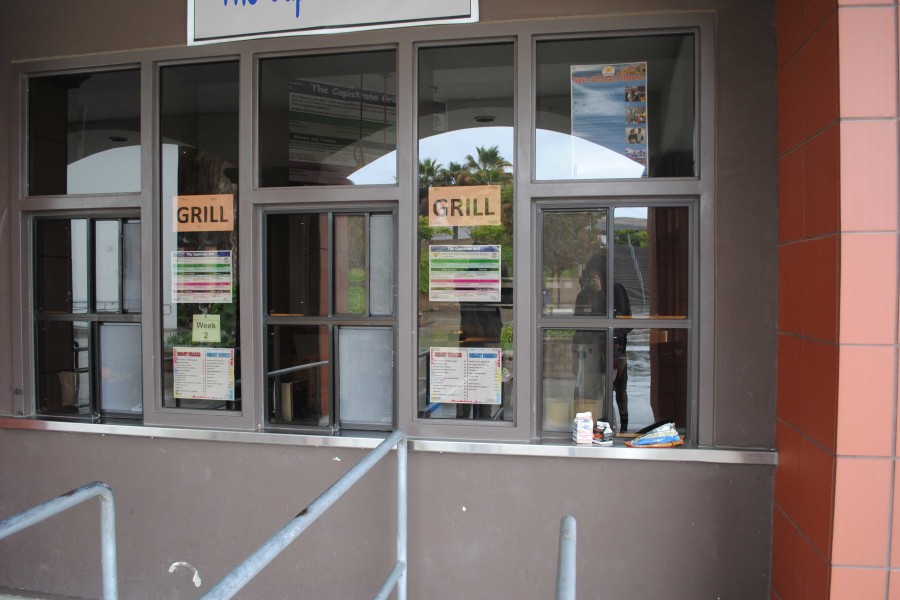School Lunches: The Facts and the Debate
Everyday, hundreds of students wait in lines like these to get their lunch.
May 14, 2015
Cafeteria food is a recurring topic amongst SJHHS students.
Some believe that the food provided is appetizing and promotes wellness. Others believe that the food is high in fat, sodium, and calories, and therefore choose to bring food from home.
Ivan Santana (10) has been buying food at the cafeteria everyday since he was a freshman, and believes that “they have really stepped up their game. As I was told by my sister, they used to not be as diverse as they are now, and I’m pretty happy, to be honest; I’m not complaining”. He continued to add that some meals are better than others, but, he enjoys the food nonetheless.
Some SJHHS students are not as fond of the school lunches as others.
Newara Faltas (10) used to buy lunch at SJHHS until “they just got really nasty… it would be nice if the kids were actually informed of what was in the foods. Because some of the foods are really nasty and I do not know what I’m putting into my body.”
Health teacher Aaron Flowers believes there needs to be a change in the school lunches nutritionally. “I also know that there are a lot of other things that play and there is budget and a lot of other restrictions and things that they have to take into account. They do they best they can but, nutritionally, I would like to see it upgraded”.
Flowers’ biggest concern with the school lunches is the “lack of nutrients in the food” and “high amounts of added sugar that we already consume on a daily basis. Foods like brownies cookies, and cakes, all of that adds to it and in the long term it can lead to diabetes and other chronic illnesses.”
Taylor Murawski (11) likes that the cafeteria has a wide variety of food and that the “lunches are not prepackaged.” However, she went on to add that she “[feels] like it’s kind of gross how they try to mix it up with really prepackaged foods like the burritos and stuff”.
“They give really big portions for the unhealthy foods and then super small portions for the healthy food. I mean, I understand that it is probably more expensive”, said Murawski.
Nick Belshe (10) buys lunch and believes that the lunches “do promote wellness”.
Dawn Kardos is the Food Service Lead Two of SJHHS and her responsibilities are managing the ordering, making sure all of the recipes are followed, following all of the required Federal and State food guidelines, and making sure the other employees are following them as well. Essentially, Kardos runs the kitchen.
“We are part of the National School Lunch Program (NSLP) and as such we have certain guidelines and rules that are mandated by the state, as well as the Federal Government, as on to the type of food we can feed to the kids. The students, the type of recipes, how much fat an item can have, how much sugar, how much salt (which is the big one nowadays),” said Kardos.
According to the United States Department of Agriculture, “the National School Lunch Program is a federally assisted meal program operating in public and nonprofit private schools and residential child care institutions. It provides nutritionally balanced, low-cost or free lunches to children each school day.”
“But we have to ensure that what we’re mandated from them to serve a proper lunch in the program. So that’s where the lunches we have we’ve researched. We have to analyze them, we have to make sure they match those guidelines that are given every year. And they change every year,” said Kardos.
“The state wants a certain thing and the Federal has their guidelines too that they want. Big state items, you know, the state changes the à la carte a lot (which is the kind of cookies we can sell, the kind of drinks we can sell),” said Kardos.
Regarding the safety and regulations the food must meet, “Safety wise, we have to make sure the product is fresh, the temperature is very important, and how it’s prepared (you’ll see me wearing gloves)”, said Kardos.
“So far, when it comes to watching your guidelines, we have the recipe book. We have created the recipes, and once we’ve created the recipes and the students like them, then we have to get them approved by the government. We have recipe books that SJHHS is famous for”, said Kardos.
“Basically, right now we’ve got a bacon cheeseburger that we’re trying, we’re the only school that’s doing this, it’s a test project. Well, it did very, very well, and it meets the guidelines”, said Kardos.
“We don’t just throw food together down here. It’s all very precise and we don’t deviate… If we are missing an item, it does not get served that day,” said Kardos.
Students can view the nutritional facts at www.capousd.org, go to Food & Nutrition Services, hit the Menu icon, then click on SJHHS and calendar will appear showing pictures of what’s on the menu and all of the nutritional value. In fact, “out of pride we have to say that we work really hard to do exactly what we need to do here and because of that, that’s why we’ve been allowed to try new products because we try to keep track so that if it is really good. All of the pictures you see online now are from SJHHS,” said Kardos.
Kardos “would like to see [the students] eating more of the fruits, I know they throw them away, but it is mandated that they have to have a fruit or vegetable with every meal.”
Because of the organic push in American society today, the schools are also pushing for more and more organic food.
“We want to give you the best price, the best quality, the best products, so that you will want to come and meet with us,” said Kardos.
“We don’t sell junk food, we sell good food,”




Scott Schmitt • May 15, 2015 at 7:01 PM
Pertinent, informative and well written. Thanks for sharing the school’s viewpoint and attitude as well. Great job!